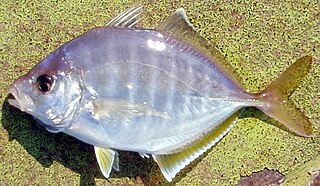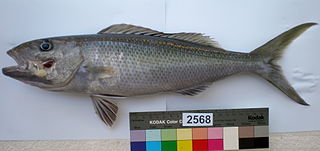The Notacanthiformes are an order of deep-sea ray-finned fishes, consisting of the families Halosauridae and Notacanthidae.

The dusky smooth-hound, also called the smooth dogfish or the dog shark, is a species of houndshark in the family Triakidae. This shark is an olive grey or brown in color, and may have shades of yellow or grayish white. Females live to 16 years and males have a lifespan of 10 years. M. canis was the first shark recognised to have viral infections.

The Atlantic mackerel, also known as Boston mackerel, Norwegian mackerel, Scottish mackerel or just mackerel, is a species of mackerel found in the temperate waters of the Mediterranean Sea, the Black Sea, and the northern Atlantic Ocean, where it is extremely common and occurs in huge shoals in the epipelagic zone down to about 200 m (660 ft). It spends the warmer months close to shore and near the ocean surface, appearing along the coast in spring and departing with the arrival of colder weather in the fall and winter months. During the fall and winter, it migrates out into deeper and more southern water, seeking warmer temperatures.

The porbeagle or porbeagle shark is a species of mackerel shark in the family Lamnidae, distributed widely in the cold and temperate marine waters of the North Atlantic and Southern Hemisphere. In the North Pacific, its ecological equivalent is the closely related salmon shark (L. ditropis). It typically reaches 2.5 m (8.2 ft) in length and a weight of 135 kg (298 lb); North Atlantic sharks grow larger than Southern Hemisphere sharks and differ in coloration and aspects of life history. Gray above and white below, the porbeagle has a very stout midsection that tapers towards the long, pointed snout and the narrow base of the tail. It has large pectoral and first dorsal fins, tiny pelvic, second dorsal, and anal fins, and a crescent-shaped caudal fin. The most distinctive features of this species are its three-cusped teeth, the white blotch at the aft base of its first dorsal fin, and the two pairs of lateral keels on its tail.

The spiny dogfish, spurdog, mud shark, or piked dogfish is one of the best known species of the Squalidae (dogfish) family of sharks, which is part of the Squaliformes order.

The black swallower, Chiasmodon niger, is a species of deep sea fish in the family Chiasmodontidae. It is known for its ability to swallow fish larger than itself.
The snubnosed eel, Simenchelys parasitica, also known as the pug-nosed eel, slime eel, or snub-nose parasitic eel, is a species of deep-sea eel and the only member of its genus. Some authors classify it as the sole member of the subfamily Simenchelyinae of the family Synaphobranchidae, or cutthroat eels, while others place it in its own monotypic family, the Simenchelyidae. It is found in the Atlantic and Pacific Oceans, typically at a depth of 500–1,800 m (1,600–5,900 ft) near the bottom. Although typically a scavenger, it is better known for using its powerful jaws and teeth to burrow into larger fishes as a parasite. This species is harmless to humans and of no interest to fisheries. The generic name Simenchelys translates literally as "pug-nosed eel".
The spiny-back eel, Notacanthus sexspinis, is a deep-sea spiny eel of the genus Notacanthus, found in all the Southern Hemisphere oceans at depths between 500 and 1,000 m. The length of this fish is up to 60 cm (24 in).

The brown lanternshark or bristled lanternshark is a little-known species of deep-sea dogfish shark in the family Etmopteridae. It is found off Japan and New Zealand, and possibly also South Africa and Australia, typically deeper than 300 m (980 ft). This species can be distinguished from other lanternsharks by its coloration, which is a uniform dark gray or brown without the ventral surface being much darker and clearly delineated from the rest of the body. The brown lanternshark feeds on small bony fishes, cephalopods, and crustaceans. Reproduction is ovoviviparous, with females giving birth to 9–18 young. An unusually high proportion of individuals in Suruga Bay are hermaphrodites, with both male and female characteristics.

The European conger is a species of conger of the family Congridae. It is the heaviest eel in the world and native to the northeast Atlantic, including the Mediterranean Sea.

The tub gurnard, also known as the sapphirine gurnard, tube-fish, tubfish or yellow gurnard, is a species of marine ray-finned fish belonging to the family Triglidae, the gurnards and sea robins. It is found in the eastern Atlantic Ocean. It is exploited by commercial fisheries as a food fish.

The whitefin trevally, also known as the horse trevally, is a species of deep water offshore fish in the jack family Carangidae. The species inhabits the tropical to temperate waters of the Indo-Pacific and central Pacific, ranging from South Africa in the west to Hawaii in the east. The whitefin trevally is a moderate-sized fish, growing to 37 cm, and is distinguished by a number of morphological traits, including fin size, gill raker count, and colour. It inhabits the continental shelf and slope at depths to 200 m over sand and mud substrates, where it preys on fish, crustaceans, and cephalopods. Studies in Japan indicate a length at sexual maturity of 17.4 cm on average, with spawning occurring between May and October, with each individual spawning multiple times. Whitefin trevallies are of high importance to fisheries in Japan, where they are taken by trawlers, although the catch numbers have halved since the 1980s. It is of minor importance elsewhere throughout its range, but is considered a good table fish.

The shagreen ray, also known as shagreen skate or fuller's ray, is a species of skate in the family Rajidae. This ray is found in the eastern Atlantic Ocean, from Murmansk, Russia through Norway, southern Iceland, the Faroe Islands, the Celtic Sea, the northern North Sea and Skagerrak, to western Morocco and the Madeira archipelago, but not in the shallow waters off England and Wales. It is also recorded sporadically in the Mediterranean Sea.

The snake mackerel is the sole species of fish in the monotypic genus Gempylus, belonging to the family Gempylidae. It is found worldwide in tropical and subtropical oceans between the latitudes of 42°N and 40°S; adults are known to stray into temperate waters. It is found to a depth of 600 meters. Populations of the snake mackerel from the Atlantic and the Indo-Pacific differ in vertebral count and number of first dorsal fin spines, and so may represent separate species.

Coastal fish, also called inshore fish or neritic fish, inhabit the sea between the shoreline and the edge of the continental shelf. Since the continental shelf is usually less than 200 metres (660 ft) deep, it follows that pelagic coastal fish are generally epipelagic fish, inhabiting the sunlit epipelagic zone. Coastal fish can be contrasted with oceanic fish or offshore fish, which inhabit the deep seas beyond the continental shelves.

The green jobfish, also known as the gray jobfish, gray snapper, or slender snapper, and in Hawaiian as uku, is a species of marine ray-finned fish, a snapper belonging to the family Lutjanidae. It is found in the Indo-Pacific region. This species inhabits various reef environments at depths from near the surface to 120 metres (390 ft). It is a very important species for local commercial fisheries and is popular as a game fish, though it has been reported to cause ciguatera poisoning. It can also be found in the aquarium trade. This species is the only known member of its genus.

Harpagifer, the spiny plunderfishes is a genus of marine ray-finned fishes, belonging to the family Harpagiferidae, it is the only genus in this monotypic family. They are found in the Southern Ocean.
Notacanthus is a genus of spiny eels in the family Notacanthidae.

The Pacific spiny dogfish is a common species of the Squalidae (dogfish) family of sharks and are among the most abundant species of sharks in the world. This species is closely related to Squalus acanthias and for many years they were treated as a single species. Recent research, using meristic, morphological and molecular data led to the resurrection of Pacific Spiny Dogfish as a separate species. The American Fisheries Society recommends the common name "Pacific Spiny Dogfish" for Squalus suckleyi over alternatives such as "Spotted Spiny Dogfish" and "North Pacific Spiny Dogfish" and "Spiny Dogfish" for Squalus acanthias.
The shortfin spiny eel, also called Bonaparte's spiny eel, is a member of the family Notacanthidae, the deep-sea spiny eels, which are not true eels (Anguilliformes).















